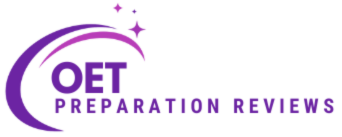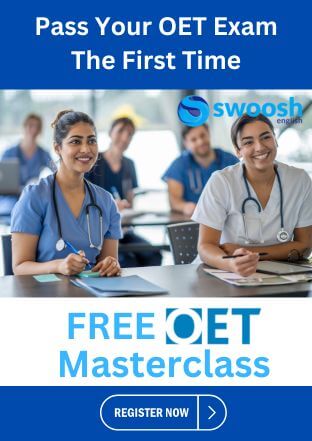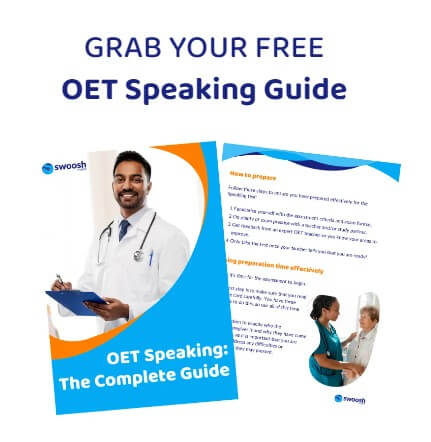The Occupational English Test (OET) is for healthcare professionals aiming to work abroad.
This post explores OET’s purpose and its development for healthcare professionals.
In addition, we will offer OET preparation tips and advice. Furthermore, we will look at the exam structure and tasks for each section and also compare it to IELTS.
By the end, you will know which if the Occupational English Test is the right choice for your career goals.
Let’s dive in!

The Occupational English Test (OET) was developed for healthcare professionals. Recognised globally, it assesses English language proficiency in a medical context.
In contrast, unlike general language exams such as TOEFL or IELTS, the OET specifically focuses on the type of language used in healthcare settings.
Consequently, this ensures that professionals can communicate effectively with patients and colleagues.
Moreover, this tailored approach makes it an essential credential for those in the medical field who are seeking to work in English-speaking environments.
Purpose of the OET Exam
The Occupational English Test (OET) is, indeed, crucial for healthcare professionals wanting to work in English-speaking countries.
Specifically, it tests the essential communication skills needed in healthcare settings, thereby ensuring clarity in patient interactions, treatment explanations, and accurate documentation.
Unlike general tests, OET’s focus on medical scenarios means that it specifically assesses the ability to handle patient symptoms, treatments, and care discussions.
Consequently, this tailored approach significantly enhances patient safety and care quality, which makes the OET an invaluable exam for medical professionals worldwide

Target Audience of the OET exam
The OET is designed specifically for medical professionals. This includes individuals working in various roles, such as:
- Doctors and nurses
- Pharmacists
- Dentists
- Physiotherapists
- Occupational Therapists
Who is the Occupational English Test Recognised By?
The OET is recognized worldwide by authorities like the GMC, NMC, AHPRA, and the Medical Council of New Zealand.
Consequently, this endorsement means that the OET is trusted to standardise English proficiency among healthcare professionals.
Moreover, these organisations require non-native speakers to demonstrate their language skills, thereby ensuring they’re up to par for medical communication in their countries.

OET vs IELTS: What’s the Difference?
IELTS has a wide range, catering to students, professionals, and immigrants with general topics.
However, for healthcare workers, OET is the specialist. In fact, it focuses in on medical contexts, making it more relevant and practical for healthcare professionals.
Therefore, if you’re in the medical field, OET aligns perfectly with your needs.
Skills Assessed
Both OET and IELTS assess listening, reading, writing, and speaking. However, assessment methods differ.
OET:
OET’s listening and reading sections are, indeed, laser-focused on healthcare contexts, while, on the other hand, IELTS covers broader English skills.
Furthermore, the targeted approach of OET’s writing and speaking parts means that, for instance, doctors might compose referral letters, and nurses might outline treatment plans.
Consequently, this specialization makes OET a practical test for real-life healthcare scenarios, thereby ensuring that professionals are assessed on skills that truly matter in their field.
IELTS:
The IELTS assesses general English proficiency through its varied sections. Specifically, listening includes diverse spoken scenarios like conversations and lectures.
Whereas reading evaluates comprehension of articles and reports. Additionally, writing tasks involve essays or reports on general topics and speaking includes one-on-one discussions with an examiner.
In comparison, this broad approach contrasts with the OET’s targeted focus on healthcare, makes OET a more tailored option for medical professionals.
Which Test is Right for You?
Your choice between the Occupational English Test and the IELTS exam should align with your career goals and national requirements.
For instance, if you’re in healthcare, OET is your go-to—it focuses on real healthcare scenarios and is tailored for medical professionals.
Conversely, IELTS assesses general English proficiency and is widely recognized by employers, academic institutions, and immigration authorities.
Ultimately, it’s all about choosing the test that best fits your specific needs and goals.
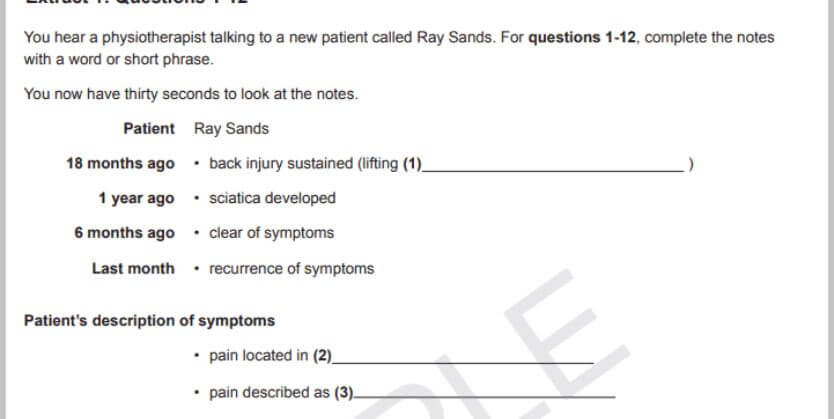
Structure of the OET Exam
In a healthcare context, the Occupational English Test assesses skills in speaking, writing, listening, and reading. This means, each section evaluates different aspects of language proficiency.
OET Listening (45 minutes)
The listening section assesses a candidate’s understanding of spoken English in medical settings. Specifically, it consists of three parts and has a duration of 45 minutes.
Part A:
As they listen to a session, candidates jot down important medical details and specifics regarding the treatment plan.
Part B:
Part of this task involves listening in on short conversations at the workplace. Specifically, candidates answer multiple-choice questions based on the information gathered from these recordings. Additionally, this process helps to evaluate their comprehension skills.
Part C:
Candidates engage with a presentation or interview focused on healthcare in this section; consequently, they utilise this information to guide their multiple-choice responses.
Conclusion
The listening sub-test, therefore, illustrates real-life situations that healthcare professionals encounter. Specifically, it focuses on utilising English understanding in patient care and communication.
OET Reading (60 minutes)
The reading sub-test assesses understanding of written English in medical contexts. It consists of three parts and has a duration of 60 minutes.
Part A:
This section, therefore, provides candidates with concise texts about healthcare. Additionally, they answer questions related to specific details relevant to medical practice.
Part B:
This part includes reading six brief workplace texts, including policy documents, emails, and memos. Specifically, candidates must respond to multiple-choice questions regarding the content of these texts.
Part C:
In this section, candidates will read two longer texts focused on healthcare-related topics. Furthermore, they will need to answer multiple-choice questions regarding the main ideas as well as specific details presented in the texts.
Conclusion
The reading section of the Occupational English Test aims to evaluate candidates’ skills in comprehending written material pertinent to healthcare practice.
Specifically,the tasks emphasise the kinds of texts that healthcare professionals regularly deal with, including patient records, medical guidelines, and research articles.
Therefore, this makes this section particularly relevant for those in the medical field.
OET Writing (45 minutes)
The writing section of the OET is tailored to specific professions; consequently, the tasks assigned to candidates vary based on their healthcare role.
For instance, a doctor may need to compose a referral letter; however, a nurse might be required to create a discharge summary.
This section has a duration of 45 minutes and aims to evaluate candidates’ proficiency in writing within a healthcare setting.
The writing task reflects a real-world scenario that healthcare professionals face in their daily work.
Candidates receive a set of case notes; therefore, they must compose a letter or document based on the provided information.
This task, therefore, evaluates candidates’ skills in organising information; additionally, it assesses their ability to utilize appropriate medical terminology.
Furthermore, it emphasises the importance of communicating clearly and effectively in writing.
Conclusion
The writing section of the Occupational English Test is, indeed, a vital component of the test, as it evaluates crucial skills that healthcare professionals rely on in their everyday tasks.
Whether it’s composing patient notes, discharge summaries, or referral letters.
The ability to communicate clearly and effectively in writing is, therefore, essential for providing patients with the highest standard of care.
OET Speaking (20 minutes)
The speaking section of the OET features role-playing scenarios that reflect real-life situations in healthcare. These are conducted with a trained examiner.
This part of the exam lasts for 20 minutes and aims to evaluate candidates’ ability to communicate effectively with patients, colleagues, and other healthcare professionals.
Furthermore, the speaking tasks are tailored to specific professions; as a result, the scenarios candidates encounter will vary based on their healthcare role.
For example, a doctor might need to explain a diagnosis to a patient; meanwhile, a nurse could be tasked with giving instructions for post-operative care.
These tasks, therefore, emphasise essential communication skills, such as clarifying medical conditions, offering treatment advice, and, in addition, responding to patient inquiries.
Conclusion
The speaking section of the Occupational English Test is designed to assess candidates’ ability to communicate clearly and effectively in spoken English in a healthcare context.
Specifically, the tasks are based on real-world scenarios that healthcare professionals encounter in their daily work; therefore, this section is highly relevant for individuals in the medical field.
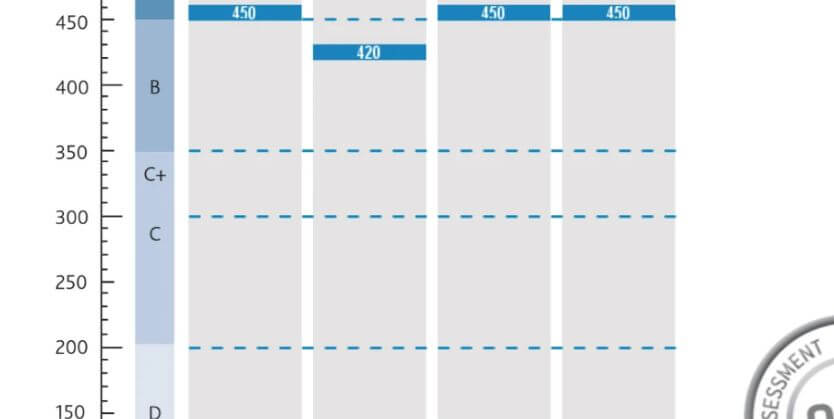
Scoring and Results
The Occupational English Test scoring system uses a letter grade scale from A to E, where A represents the highest grade and E the lowest.
Furthermore, each of the four sections—listening, reading, writing, and speaking—is scored separately. As a result, candidates are given an individual grade for each section.
-
Grade A: This grade signifies an exceptional command of English; consequently, it enables effective communication across all healthcare scenarios.
Grade B: This grade reflects a strong proficiency in English, thereby allowing for effective communication in most healthcare situations.
Grade C: This grade indicates a moderate proficiency level; however, there is some capability to communicate in healthcare settings, though occasional challenges may arise.
Grade D: This grade shows a lower proficiency level, which results in limited communication abilities within healthcare contexts.
Grade E: This grade represents a very low proficiency level, ultimately leading to significant challenges in communicating effectively in healthcare situations.
What You Need to Pass
Candidates need a Grade B or higher in all OET sections—speaking, reading, writing, and listening—to pass.
This equates to a sectional score of 350 points. Most healthcare regulatory bodies require this score.
At the end of the day, achieving this proficiency shows the applicant can communicate effectively in a healthcare environment.
Moreover, this requirement ensures candidates have essential language skills for professional roles.

How to Prepare Effectively for the OET Exam
Preparing for the Occupational English Test requires a structured approach that focuses on improving language skills.
Furthermore, it is essential to understand the test format, as well as to use effective study methods.
Here’s a detailed plan for successful preparation:
Start Early
Start preparing early. In fact, it’s crucial for healthcare professionals aiming to work in an English-speaking environment.
Moreover, early preparation provides time to understand the test’s format and content.
Consequently, this greatly influences exam performance. Furthermore, it improves confidence and reduces anxiety.
Be Realistic About Your Preparation Time
Set realistic goals for your study plan. This means, taking a moment to assess your current situation, such as your current working schedule and your family life.
In conclusion, set aside time to study consistently with no disturbances.
Identify Your Weaknesses
Identifying your areas of weakness is essential for passing the test. This means, if you can recognize them early, you have the chance to improve before the test day.
Furthermore, taking an exam readiness test from a reputable company like Swoosh English can help you pinpoint exactly where to focus your efforts.
Once you have a clear understanding of your weak points, you can improve your preparation by concentrating on those specific skills.
Consequently, by addressing and gradually improving your weak areas, you can boost your confidence and ensure that you’re ready to perform your best on test day.
Understand the Test Criteria
Taking the Occupational English Test exam without understanding its structure is a big mistake.
However, if you’re not familiar with how it works, you might feel unprepared. Each section—Listening, Reading, Writing, and Speaking—has specific tasks. Therefore, it’s important to know exactly what is expected in each part.
Moreover, it’s highly recommended to seek professional advice and feedback in order to gain complete clarity.
Ultimately, being familiar with the format boosts your confidence and helps the exam go more smoothly.
Improve Your Language Skills
Don’t just take practice mock exams; rather, focus on improving your overall language skills.
Additionally, consider enrolling in OET preparation courses. These courses, in fact, offer a comprehensive understanding of speaking, writing, listening, and reading.
Moreover, engage with materials that include medical terminology used in different healthcare settings.
Practice Regularly
Incorporate practice into your daily routine; however, don’t just stick to practice mock exams.
For better results, in addition, explore a range of activities. For instance, read articles on healthcare from trustworthy journals or websites.
To improve your listening skills, you should also listen to lectures or medical podcasts. Moreover, engage in role-playing with expert teachers to imrpove your patient communication abilities.
Furthermore, do not rely on feedback from your friends, family, or passing students; they are NOT the experts.
Instead, get expert feedback from a premium OET preparation provider with expert teachers.
Access official OET preparation materials
Relying on free information can often lead to confusion and overwhelm; therefore, it’s best to avoid constantly seeking freebies.
Furthermore, to maintain your focus and avoid falling into negative patterns, use resources from trustworthy companies instead.
This approach, in turn, will help you stay on track for success.
Practice writing tasks
Using medical terminology effectively is crucial when composing assignments like discharge summaries and referral letters.
Furthermore, this can be difficult without relevant examples or feedback.
Therefore, it is strongly advised to enroll in a recognised preparation course to receive professional feedback and writing revisions.
Consequently, this will help you identify your areas for improvement.
Create a Study Plan
Create a comprehensive study plan that dedicates time to speaking, writing, listening, and reading.
Furthermore, stick to it consistently.
In fact, a well-organised approach ensures consistent improvement in all key skill areas and helps maintain your focus.
Additionally, consider joining an OET preparation course so that the experts can identify your weak areas and develop a study plan around improving them.
Seek Expert Feedback
It’s beneficial to seek feedback from expert OET teachers who are proficient in English.
Moreover, their constructive critiques can provide valuable insights.
In addition, you can use this feedback to identify areas that need improvement, which you might overlook when assessing your own work.
Furthermore, it is important to note that your friends and colleagues are not experts.
In other words, that is like asking a friend to teach you how to drive.
Consequently, that would be a disaster and very dangerous.
Book Your OET Exam When Ready
Only schedule your Occupational English Test when you are confident in your ability to pass all sections of the test.
Furthermore, rushing to book a spot can lead to poor preparation. Consequently, on the day of the test, this might result in less than ideal performance.
Therefore, take your time before scheduling your exam date and ensure you are thoroughly prepared.
In addition, it is recommended to commit at least 3 months to your OET preparation.
Moreover, it is invaluable to get an expert OET teacher to tell you when you are ready to book the exam date.

How NOT to Prepare for the Occupational English Test
Do Not Delay Preparation
Procrastinating on your preparation can lead to frantic last-minute studying; therefore, it’s best to steer clear of that.
Moreover, cramming often results in failing the exam and multiple attempts.
Instead, to avoid this, start your studies early to gain a solid grasp of the language required for the OET.
Furthermore, consistent practice will significantly increase your chances of success.
Do Not Rely Soley on Practise Mock Exams
While practice exams are important for understanding the format and timing of the test, they shouldn’t be your sole focus.
Moreover, it’s essential to also improve your vocabulary, grammar, and comprehension skills.
Additionally, incorporate a range of resources into your study plan to enhance your learning experience.
Ultimately, this approach will help you build a more well-rounded skill set.
Do Not Self Study
Studying alone can sometimes feel isolating and uninspiring. However, on the other hand, self-study is risky, as you will not receive any expert feedback.
Consequently, this means you will not understand where you are going wrong or where you need to improve.
Therefore, it is invaluable to join a premium preparation provider like Swoosh English that can identify your weaknesses, create a clear study plan, and find you the perfect study partner.
Furthermore, having access to live classes, readiness tests, mock exams, writing corrections and feedback is powerful in order to boost confidence for the OET exam.
Avoid Using Free OET Study Material
It is important to avoid using unapproved resources; otherwise, they may not accurately reflect the format or content of the test.
As a result, you will feel confused, overwhelmed and experience information overload.
Therefore, always choose official OET materials from reputable companies, such as Swoosh English.
By using official materials, you ensure that you are well-prepared for the test.

Common Mistakes Made for Preparing for the OET Exam
For many applicants, preparing for the Occupational English Test (OET) can be quite challenging.
Moreover, many people tend to make common mistakes during their preparation.
Consequently, these errors can effect their chances of passing the test.
Therefore, it’s important for candidates to avoid these typical errors.
Ultimately, successful preparation starts with recognising these mistakes:
- Lack of Preparation: Not studying enough is a frequent mistake. As a result, many candidates underestimate the test’s complexity, thinking their current English language skills are enough.
- Failing to Practice Under Exam Conditions: Candidates often skip timed mock exam practice. Consequently, this leads to poor time management.
- Neglecting Reading and Listening Components: Candidates often prioritise speaking and writing. Which means they overlook listening and reading. In the end, this can negatively affect their scores.
- Overcomplicating Writing Tasks: Candidates may use advanced vocabulary in writing. As a result, this can reduce clarity. In fact, the primary aim should be clear communication.
- Not Using Appropriate Medical Language: Misunderstandings can occur when using everyday language instead of medical terms. Therefore, success depends on knowing medical vocabulary well.
- Ignoring Task Requirements: Every OET task has unique guidelines. Consequently, not following them can lower scores. Therefore, following the instructions is crucial.
- Not Reviewing Performance After Practice Mock Tests: Candidates often skip reviewing practice tests. Consequently, they miss valuable insights. Moreover, regular reflection helps tailor effective study plans.
- Time Management: Poor time management leads to incomplete sections or rushed answers. Therefore, timed practice is vital for pacing strategies.
- Skipping Mock Tests: Neglecting mock tests denies essential exam condition experience. Thus, they are crucial for building confidence and familiarity with the test format.
- Not Seeking Professional Help: Many candidates self-study without expert guidance. As a result, they don’t realise their mistakes. In fact, expert feedback is key to identifying needed improvements.
Do’s and Don’ts of OET Exam Day
Do’s:
- First, fuel up with a healthy breakfast like eggs, grains, and fruits.
- Next, choose comfortable clothes to move easily.
- Additionally, arrive early to avoid jitters.
- Furthermore, read instructions carefully to avoid mistakes.
- Finally, stay calm with deep breaths and positive thoughts. Remember, you’ve got this!
Don’ts:
- Don’t cram last minute, this will result in stress.
- Moreover, don’t doubt yourself, trust your preparation.
- In addition, don’t panic if stuck; instead, move on and return later.
- Furthermore, Don’t question yourself, if the answer feels right, accept it.
- Additionally, Don’t burn out, take breaks to stretch and breathe.
- Finally, don’t be hard on yourself, enjoy the challenge and have fun!
How to Book the OET Exam
Booking the Occupational English Test involves several steps. Paper or computer tests differ slightly. Here’s the process:
https://oet.com/test/book-a-test
- Determine your test type (Paper or online)
- Next, identify your preferred test venue and format.
- Check available OET exam dates for both formats.
- Select a date that fits your schedule.
- Create an account on the OET website if needed.
- Fill out the application form with personal details.
- Choose your test type, venue, and date.
- Pay for your exam using an accepted method.
- Complete this step before the booking deadline.
- Receive a confirmation email after payment. Keep it for exam day details.
- Start preparing using available study materials and resources.
Conclusion
Choosing between OET and IELTS requires considering career goals and application requirements. Moreover, OET has advantages for healthcare professionals.
OET focuses on healthcare-specific tasks, recognized by regulatory bodies. Additionally, it uses real-world scenarios. For healthcare professionals, OET offers practical language assessment.
Profession-specific tasks test skills used in jobs, making Occupational English Test more applicable than IELTS. Consequently, it ensures relevant communication skills.
OET assesses skills needed for quality patient care. Therefore, it suits doctors, nurses, pharmacists, and physiotherapists. Ultimately, OET demonstrates English proficiency for healthcare careers.
Final Thoughts
Before booking the Occupational English Test, prepare well. Use a premium provider like Swoosh English for support. Let expert teachers guide you and let you know when you are ready to book the OET exam date.
OET is life-changing once you pass. View it as an investment for your future. Don’t gamble with self-study.
Get expert feedback to pass the first time. Thanks for reading, and best of luck with your OET exam!
